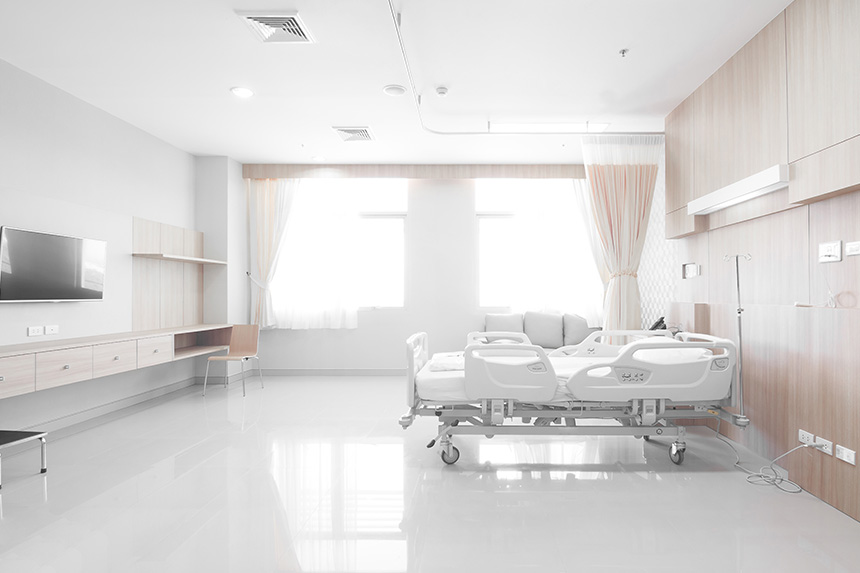Updated January 2020
What is Uncompensated Care?
According to the American Hospital Association (AHA), U.S. hospitals have provided more than $620 billion in uncompensated patient care over the last 20 years. Acute care hospitals across the country provide uncompensated care to patients who are uninsured, impoverished, or who otherwise cannot pay for their medical care. Uncompensated care—referring to both charity care and bad debt—is the total monetary value of hospital-administered care for which no payment was received from either the patient or the insurer.
Charity care refers to treatment or services for which a hospital did not expect to receive payment because a patient was identified as unable to pay. This type of pro-bono funding is regulated by a hospital’s charity care policy, and patient financial status and eligibility are typically determined before admission or care provision. In cases of emergency or missing patient information, charity care can also be extended to certain patients following hospital admission. There are several factors hospital leaders consider when establishing a patient’s financial standing, including: income, assets, employment status, and additional sources of funding.
Bad debt, unlike charity care, refers to care services for which a hospital expected payment, but did not receive it. This situation arises when a patient is unable or unwilling to pay a hospital bill and, in this case, has also not taken steps to request financial assistance. The hospital then issues a bill that goes unpaid.
In many cases, patients accrue unforeseen medical debt when insurers issue charges for out-of-network providers—providers that, quite often, deliver care while a patient is unconscious or rendered medically unable to make a choice regarding the type of physician (in-network or out-of-network) or treatment they would prefer. While this proactive approach to care delivery is vital in order to provide fast, life-saving care, it also means that patients sometimes find themselves saddled with thousands of dollars in medical debt for treatment that they didn’t opt to receive.
Effects of Uncompensated Care
Hospitals and other care facilities are not viable if they leave gaps in payment and must allocate funds to cover hospital bad debt and charity care costs. This, of course, leaves less money to pay physicians and staff, obtain essential medical supplies, and provide other health and wellness initiatives.
Some hospitals can offset their uncompensated care costs through disproportionate share hospital (DSH) payments. This funding is sponsored by both federal and state governments to improve financial stability for safety-net providers and other hospitals that serve large populations of Medicaid beneficiaries or uninsured patients. These payments are, however, strictly regulated and are not available to all acute care facilities.
More than that, DSH funding is set to fall by $44 billion in the next five years. In February 2018, Congress passed a bipartisan budget bill to reduce available DSH funding by $4 billion in 2020 and increase the annual payment reduction to $8 billion through 2025.
What happens when the payment gap inevitably widens? In order to raise funds, hospitals and care facilities might implement cost-shifting measures. In this situation, hospitals charge insured patients more than uninsured patients for the same treatment or procedure in order to cover the financial loss of providing care to those who are uninsured, or who receive federally funded insurance. Hospitals might also seek to increase care costs, which prompts insurers to raise their rates and could make insurance coverage unaffordable for more patients.
Generally, the greater the number of insured patients—privately or through federally-funded programs like Medicaid—the lower bad debt ratios and overall care costs will be.
Hospitals with the Highest Bad Debt Ratios
| Rank | Hospital Name | Definitive ID | State | Net Patient Revenue | Bad Debt Ratio |
| 1 | Mercy Hospital Berryville | 227 | AR | $16,507,238 | 198.80% |
| 2 | Dallas Regional Medical Center | 3913 | TX | $90,907,740 | 176.10% |
| 3 | Lehigh Regional Medical Center | 829 | FL | $37,402,572 | 146.70% |
| 4 | Southeastern KY Medical Center | 1636 | KY | $6,761,585 | 127.90% |
| 5 | LifeBrite Community Hospital of Early | 984 | GA | $10,835,703 | 126.50% |
| 6 | Crockett Medical Center | 972395 | TX | $9,889,448 | 125.40% |
| 7 | Sherman Oaks Hospital | 426 | CA | $101,654,786 | 124.40% |
| 8 | Parkland Health and Hospital System | 3931 | TX | $803,598,250 | 113.20% |
| 9 | Tanner Medical Center - East Alabama | 866201 | AL | $5,825,834 | 109.30% |
| 10 | Crescent Medical Center Lancaster | 575750 | TX | $35,838,533 | 103.50% |
Fig 1 Financial metrics from Definitive Healthcare’s comprehensive Hospital & IDN platform. Data from the 2018 Medicare Cost Report, the most recent data available. In this data table, the “Bad Debt Ratio” refers to Bad Debt to Net Patient Revenue ratio. Note: U.S. territories have been omitted from this data table for the purposes of state analysis.
Approximately 21 percent of all active hospitals—or roughly 1,505 facilities—reported $10 million or more in bad debt in 2018, with one hospital claiming as much as $909 million in unrecoverable funds.
All the top ten hospitals with the highest reported bad debt ratios in 2018 have uncollected debt exceeding their net patient revenue—resulting in a debt to net patient revenue ratio greater than 100 percent. This is, surprisingly, a considerable improvement on the bad debt ratios reported in the 2017 fiscal year.
In 2017, one hospital reported a bad debt to net patient revenue ratio as high as 365 percent. This facility has, perhaps unsurprisingly, subsequently closed for this and a variety of other reasons. Though bad debt ratios have improved from 2017 to 2018, these consistently high levels of unrecoverable funds raise questions about why, exactly, hospitals are facing this issue.
In recent years, the U.S. has seen an increase in the total number of uninsured Americans. In 2018, the U.S. Census reported 27.5 million people without health insurance at any point during the year—up from 25.6 million reported in 2017. While this is certainly not the only cause for an increase in bad debt ratio, it does contribute to a rise in hospital uncompensated care.
Unreimbursed Medicare & Medicaid Costs
Medicare and Medicaid are both government healthcare programs that help Americans secure coverage, but their reimbursement structures differ significantly by program and by state. The U.S. Department of Health & Human Services describes Medicare as an “insurance program,” whereas it characterizes Medicaid as an “assistance program.”
The greatest difference between Medicare and Medicaid reimbursement structures is that Medicaid regulations and reimbursement models vary from state to state. In this respect, Medicaid is very similar to the private insurance market—where payers negotiate different procedures and payment amounts based on the provider and service(s) administered.
According to the Medicaid and CHIP Payment Access Commission (MACPAC), some states reimburse hospitals based on reported costs, while others issue payments based on the length of a reported hospital stay. Most states have adopted reimbursement models based on diagnosis-related groups (DRGs), where hospitals are paid a fixed amount per patient discharge under a traditional fee-for-service model.
There is one thing that all states share in their Medicaid reimbursement models, and that is the amount that Medicaid pays to its providers. Medicaid reimbursements are typically less than 100 percent of the Medicare amount for the same care services. According to a 2016 study from The Urban Institute, Medicaid programs paid physicians fees at 72 percent of Medicare rates.
Hospitals with the Highest Unreimbursed Medicaid Costs
| Rank | Hospital Name | Definitive ID | State | Net Patient Revenue | Unreimbursed Medicaid Costs |
| 1 | Kaiser Sunnyside Medical Center | 3380 | OR | $334,298,837 | $6,911,138,786 |
| 2 | Kaiser Permanente Moanalua Medical Center | 1081 | HI | N/A | $2,603,752,337 |
| 3 | Kaiser Permanente Westside Medical Center | 577679 | OR | $168,568,937 | $1,515,785,767 |
| 4 | LAC & USC Medical Center | 476 | CA | $813,656,534 | $416,573,572 |
| 5 | NYC Health and Hospitals - Elmhurst | 2879 | NY | $512,347,436 | $369,493,160 |
| 6 | NewYork-Presbyterian/Weill Cornell Medical Center | 541974 | NY | $5,951,047,108 | $296,786,208 |
| 7 | Yale New Haven Hospital | 731 | CT | $2,749,659,018 | $278,425,465 |
| 8 | NYC Health and Hospitals - Lincoln | 2753 | NY | $520,884,451 | $261,315,032 |
| 9 | NYC Health and Hospitals - Kings County | 2806 | NY | $660,676,560 | $209,850,701 |
| 10 | NYC Health and Hospitals - Queens | 2878 | NY | $440,830,422 | $204,469,167 |
Fig 2 Financial metrics from Definitive Healthcare’s comprehensive Hospital & IDN platform. Data from the 2018 Medicare Cost Report, the most recent data available.
Definitive Healthcare tracks unreimbursed Medicaid costs for over 7,200 U.S. hospitals. In 2018, the top 10 hospitals alone reported a total of $13 billion in unreimbursed Medicaid expenses. With almost $7 billion in unreimbursed Medicaid costs, Kaiser Sunnyside Medical Center reported the highest unreimbursed program expenses in 2018.
With unreimbursed costs such as these, one might anticipate similar reports of uncollected debt or, in this case, a particularly high bad debt to net patient revenue ratio. Kaiser Sunnyside Medical Center reported only $8.2 million in unrecoverable funds—with a bad debt to net patient revenue ratio of just 2.5 percent.
In fact, all top 10 hospitals by unreimbursed Medicaid costs have a bad debt ratio of 15.1 percent or less. These much lower bad debt ratios are most likely due to factors like hospital size and patient demographic. Many of the top hospitals by bad debt ratio are smaller, rural-area hospitals that not only have lower net patient revenues but also serve a greater population of uninsured patients. In contrast, almost all of the top hospitals by unreimbursed Medicaid costs serve large, urban populations with greater access to either private or publicly-sponsored insurance programs.
Learn more
Interested in learning more about hospital bad debt, risk management, and revenue cycle management? Definitive Healthcare tracks financial and clinical metrics for 8,800 U.S. hospitals and health systems. Start a free trial today to see how you can:
-
- Look for important investment & lending opportunities
- Assess provider financial insights and financial strength indicators
- Identify the healthcare organizations that could most benefit from your services





